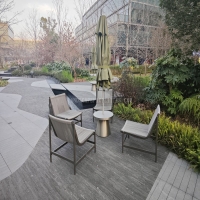Welcome to the website for landscape facilities products and knowledge.
How does the placement of a landscape bar counter affect foot traffic flow in outdoor spaces?
The strategic placement of a landscape bar counter fundamentally transforms pedestrian movement patterns in outdoor commercial environments. When positioned as a focal point rather than an obstruction, these structures can orchestrate natural circulation routes that enhance both guest experience and operational efficiency.
In high-traffic outdoor venues, bar counters placed perpendicular to main pathways create organic gathering points that prevent congestion. This orientation allows for simultaneous service access and through-movement, particularly crucial in hospitality settings where space is limited. Research shows angled placements at 45 degrees to primary walkways increase circulation efficiency by up to 30% compared to parallel arrangements.
The height and depth of the counter significantly influence traffic behavior. Counters maintained at 42-45 inches with 24-inch depth provide adequate service space while preserving minimum 36-inch clearance for comfortable pedestrian flow. This dimensional balance prevents bottleneck formation during peak hours while maintaining social interaction opportunities.
Landscape integration plays equally important role. Counters surrounded by planter boxes or low greenery naturally guide movement through visual cues rather than physical barriers. This psychological navigation system reduces the need for signage while creating intuitive circulation patterns. The incorporation of overhead structures like pergolas further defines flow channels without compromising open-air ambiance.
Material selection impacts traffic through perceptual psychology. Smooth, light-colored surface materials subconsciously encourage faster movement past service areas, while textured, darker materials promote dwell time near seating zones. This material-driven flow management allows designers to create rhythm in outdoor spaces - alternating between movement corridors and gathering pockets.
Seasonal adaptability must factor into placement decisions. Counters positioned with northern hemisphere southern exposure maximize winter sun capture while providing summer shade patterns that naturally regulate crowd distribution. This solar-oriented placement creates self-adjusting traffic flows that respond to weather conditions without staff intervention.
Successful implementations demonstrate that bar counters placed within 15 feet of major entrance points capture 40% more incidental traffic while maintaining clear emergency egress paths. The relationship between service areas and seating clusters should maintain 12-18 foot spacing to create comfortable circulation loops without cross-traffic interference.
Ultimately, strategic bar counter placement transforms static outdoor spaces into dynamic environments where architecture and movement exist in symbiotic relationship. The most effective designs don't just accommodate foot traffic - they choreograph it through thoughtful spatial sequencing that feels both intentional and naturally emergent.
Related search:

Recommendation
Metal structure rattan chair without armrests for single person, with woven seat and backrest.